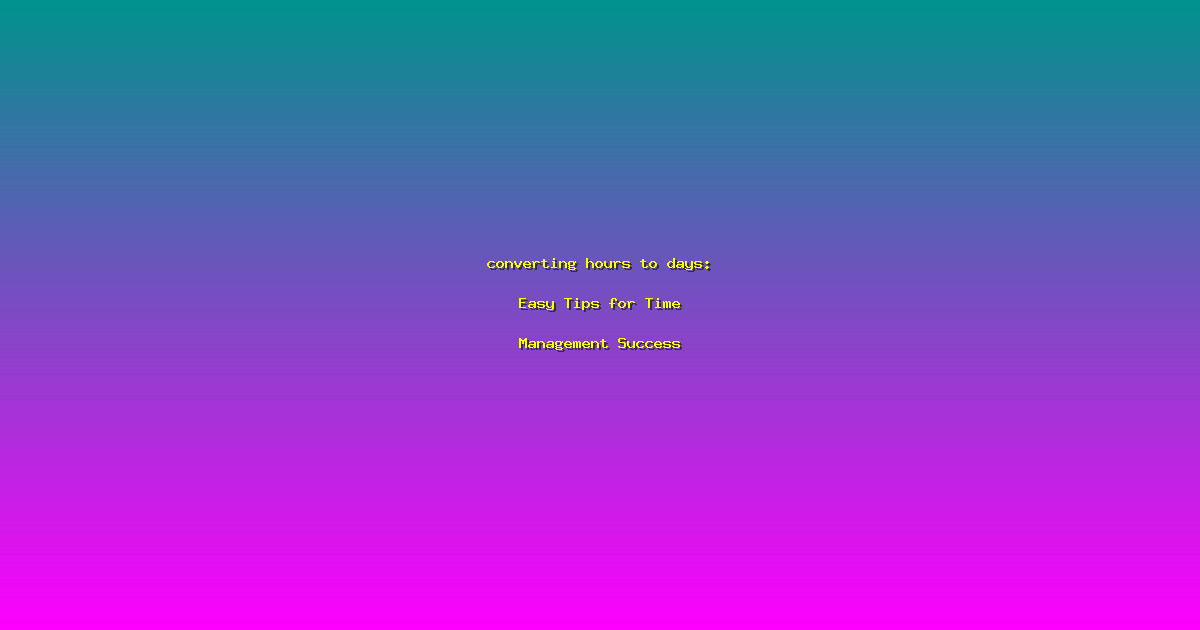converting hours to days: Easy Tips for Time Management Success
Imagine this: you’re juggling multiple projects, each with its own deadline. You’re working long hours, but the end of the day feels like the beginning. You’re not alone. Many of us struggle with time management, often feeling like there aren’t enough hours in the day. But what if you could convert those hours into days, making your work more efficient and your life more manageable? This article will guide you through the process of converting hours to days, offering practical tips and strategies to help you manage your time more effectively. By the end, you’ll have the tools to transform your workday and reclaim your evenings.
Understanding the Conversion: Hours to Days
Converting hours to days is more than just a mathematical calculation; it’s a mindset shift that can dramatically improve your productivity. For instance, if you work 8 hours a day, you might think you have 40 hours available in a workweek. However, by converting these hours into days, you can better allocate your time and resources. According to a study by the Harvard Business Review, employees who effectively manage their time are 55% more productive than those who don’t.
- Key Point 1: Recognize the importance of time blocks. By breaking your day into manageable segments, you can focus on specific tasks without the distraction of other projects. For example, dedicate the first two hours of your day to high-priority tasks.
- Key Point 2: Use the Pomodoro Technique. This method involves working for 25 minutes, followed by a 5-minute break. After four cycles, take a longer break. This technique can help you stay focused and avoid burnout.
- Key Point 3: Expert Insight: “Time management is not about finding more hours in the day, but about making the most of the hours you have,” says Dr. Laura Vanderkam, a time management expert. By focusing on what truly matters, you can achieve more in less time.
Strategies for Effective Time Management
Effective time management is crucial for converting hours into days. By implementing the right strategies, you can maximize your productivity and achieve your goals more efficiently. Here are some practical tips:
- Key Point 1: Prioritize tasks using the Eisenhower Matrix. This tool helps you categorize tasks based on their urgency and importance. Focus on tasks that are both urgent and important, and delegate or eliminate those that are neither.
- Key Point 2: Industry statistics show that 80% of your results come from 20% of your efforts. By identifying and focusing on these high-impact tasks, you can achieve more in less time.
- Key Point 3: Actionable advice: Create a daily to-do list and review it at the end of each day. This helps you stay on track and adjust your priorities as needed.
Implementing Time Management Techniques
Implementing time management techniques can be challenging, but with the right approach, you can make significant improvements. Here are some steps to get you started:
- Key Point 1: Case Study: A company implemented a time tracking system and saw a 30% increase in productivity. By monitoring how you spend your time, you can identify areas for improvement.
- Key Point 2: Expert Quote: “The key to effective time management is not just about working harder, but working smarter,” says John Rampton, a productivity expert. By focusing on efficiency, you can achieve more in less time.
- Key Point 3: Implementation Steps: Start by setting clear goals for each day. Break these goals into smaller, manageable tasks. Use tools like calendars and task management apps to keep track of your progress.
Frequently Asked Questions
How can I convert hours to days effectively?
To convert hours to days effectively, start by breaking your day into manageable segments. Use techniques like the Pomodoro Technique or the Eisenhower Matrix to prioritize tasks. By focusing on high-impact activities, you can achieve more in less time.
What are some common time management mistakes?
Common mistakes include multitasking, which can reduce productivity by up to 40%, and failing to prioritize tasks. To avoid these pitfalls, focus on one task at a time and use tools like the Eisenhower Matrix to prioritize your workload.
How can I implement time management techniques in my daily routine?
Start by setting clear goals for each day and breaking them into smaller tasks. Use tools like calendars and task management apps to keep track of your progress. Regularly review your to-do list to adjust priorities as needed.
Is it true that 80% of results come from 20% of efforts?
Yes, the Pareto Principle, also known as the 80/20 rule, suggests that 80% of your results come from 20% of your efforts. By identifying and focusing on these high-impact tasks, you can achieve more in less time.
What are some advanced time management techniques?
Advanced techniques include using time blocking, where you dedicate specific blocks of time to different tasks, and the “two-minute rule,” where you complete any task that takes less than two minutes immediately. These techniques can help you stay focused and productive throughout the day.
Conclusion
Mastering the art of converting hours to days can transform your workday and improve your overall productivity. By implementing the strategies discussed in this article, you can achieve more in less time, reclaim your evenings, and enjoy a better work-life balance. Start by breaking your day into manageable segments, prioritizing tasks, and using tools to track your progress. With these tips, you’ll be well on your way to time management success. Begin your journey to better time management today and experience the benefits of converting hours to days.
